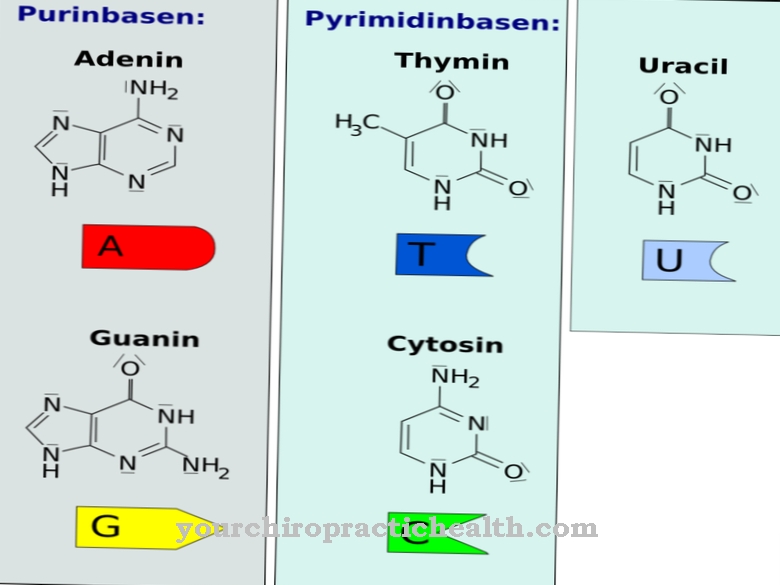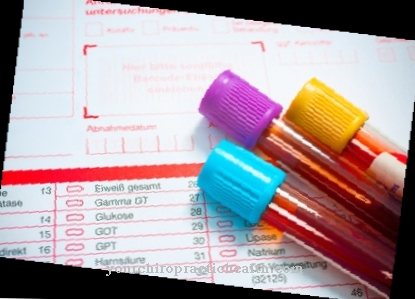Astrocytes belong to the glial cells of the central nervous system and perform important functions in the brain. They not only function as supporting cells for the neurons, but also actively participate in the exchange of information. Important pathological processes in the brain affect the activity of astrocytes.
What are astrocytes
The astrocytes are star-shaped cells in the central nervous system and represent the largest part of the glial cells. Until recently, the glial cells were regarded as pure supporting cells for the cohesion of the neurons in the nervous system. Hence the syllable "Glia", which means something like glue. The astrocytes see in a star shape b. z. w. spider-shaped because they have radial runners.
Astrocyte is derived from the Greek term star-shaped cell or star cell. Here, however, there must be no confusion with the real stellate cells, which in turn have nothing to do with the astrocytes. The real stellate cells are neuronal cells (nerve cells) and are located in the cortex and cerebellum. In addition to neurons, the brain consists of over 50 percent astrocytes. In contrast to neurons (nerve cells), they did not appear to have any other functions with the exception of supporting functions.
However, the view of glial cells and especially astrocytes has changed fundamentally in recent years. According to the latest findings, the astrocytes are not just glue or cement for the neurons, but also play an outstanding role in the communication processes through close interactions with the nerve cells.
Anatomy & structure
The astrocytes in the brain are star-shaped or spider-shaped branched cells. Their processes form boundary membranes to the brain surface and blood vessels. There are two types of astrocytes in the brain. The protoplasmic glia, also called astrocytus protoplasmaticus or short rays, are components of gray matter.
The fiber glia (also Astrocytus fibrosus or long-ray radiators) occurring in the white matter are rich in fibrils. They also contain many microtubules. The astrocytes of the brain have radial cell processes that cover synapses, Ranvier constrictor rings and axons of neuronal surfaces. Furthermore, the appendages also form border structures in the central nervous system by being superposed. Your cell membrane has receptors for neurotransmitters and voltage-dependent ion channels.
They form a tight network with one another through gap junctions. It is used to electrically couple the cells. In other parts of the central nervous system, the astrocytes can also have a different structure. The elongated or rod-shaped Müller glial cells, which also belong to the astrocytes, are located in the retina of the eye.
Function & tasks
The astrocytes perform a variety of functions. It has long been known that they play a supportive role in the CNS. In addition, they provide for the nourishment of the neurons through their contacts to blood vessels through their processes. Furthermore, they maintain the potassium balance in the brain. The potassium ions released during the transmission of excitation are absorbed by the astrocytes and distributed over the entire network. This creates an effective buffer system, which also regulates the pH balance in the brain.
The ion shift is also influenced by the binding of glutamate to receptors in the membrane. There is a direct interaction between astrocytes and neurons via neurotransmitters. Electrical stimuli from the stimulus transmission of the neurons are also partially transmitted to the astrocytes. Signal transmission takes place within the astrocytes in the vicinity of the corresponding neurons. The astrocytes then have a modulating effect on the signal transmission between the neurons via a feedback mechanism. Thus, there is a constant exchange of information between the nerve cells and the glial cells.
The astrocytes act like advisors to generate an appropriate response. Another task of the astrocytes is to establish and maintain the blood-brain barrier through the formation of the membrane limitans glialis perivascularis. Severing the neuron-axons causes astrocytes to form glial scars, which inhibit the re-growth of the axons. This is a problem for patients with paraplegia. Recent research has also shown that some astrocytes in the hippocampus can serve as stem cells for neurons.
Diseases
Astrocytes play a major role in connection with neurological diseases, epilepsy, Alzheimer's disease or inflammation in nerve tissue. It could be shown that inflammatory processes in the nerve tissue lead to changes in the metabolism of astrocytes, which ensure their survival in the network. They have the ability to stop the cell death process in traumatic events such as brain injuries or strokes.
However, not much is known about the complex relationships. The studies suggest, however, that the astrocytes also play a major role in pathological processes within the nervous system. It was found that in patients with Alzheimer's disease, the astrocytes are stimulated by the increased formation of ATP. They become hyperactive and take up more calcium. Real calcium waves develop. It is not yet clear whether the hyperactivity of the astrocytes is a positive defense reaction or whether it is a negative consequence of the disease process that is making the situation worse.
Astrocytes can acquire pathological significance through increased cell proliferation. They can be the starting point for benign or malignant brain tumors. These tumors are commonly known as astrocytomas. The astrocytomas are usually benign, but often very space-consuming. They may develop into glioblastomas, which are the most common malignant brain tumors in adults.













.jpg)

.jpg)
.jpg)











.jpg)